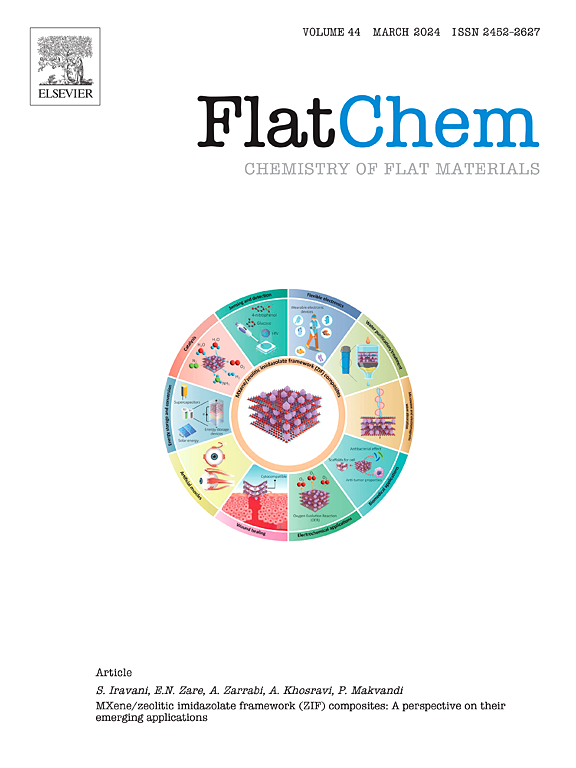石墨烯量子点/氢氧化镧(III)基 MIS 异质结构中的高频负电容
IF 6.2
3区 材料科学
Q2 CHEMISTRY, PHYSICAL
引用次数: 0
摘要
镧系元素在基于石墨烯量子点(GQDs)的电子技术方面具有巨大潜力,因为它们具有以 4f 电子为特征的独特电子构型。在此背景下,本研究将氢氧化镧(III)纳米粒子(La(OH)3NPs)用作聚乙烯亚胺(PEI)掺杂氮(N)石墨烯量子点(PEIGQDsN)的掺杂剂。采用一种新型绿色方法,以 La(NO)3 为原料,一步制备出掺杂 La(OH)3NPs 的 PEIGQDsN 纳米复合材料,并将其用作金和正硅的金属/层间/半导体(MIS)异质结的层间。在 300 K 的 500 Hz 至 3 MHz 宽频范围(-3 V 至 5 V)内,研究了金/La(OH)3NPs 掺杂 PEIGQDsN/n-Si MIS 异质结的电容和电压(C-V 和 G/ω-V)特性。特别是在 1.5 MHz 以上的高频率下,正向偏压下的正电容 (PC) 会转化为负电容 (NC)。此外,高频率下的阻抗测量是在黑暗中测量后进行的,同时以 100 mW/cm2 的功率照射结构表面。在观察到电感行为的 2 MHz 和 3 MHz 频率下,光重新填充了耗尽的阱电平,催化了正向偏压下从 NC 到 PC 的转变。这些发现表明,异质结的电容和电导具有显著的频率敏感性,在较高频率下尤为明显。这项研究的成果将极大地影响人们对基于碳-镧系元素的电子技术的理解,并能创造出用于电子或光电应用的新型混合功能材料。本文章由计算机程序翻译,如有差异,请以英文原文为准。

High-Frequency Negative Capacitance in Graphene Quantum Dots/Lanthanum(III) Hydroxide-based MIS Heterostructure
Lanthanides have significant potential for electronic technologies based on graphene quantum dots (GQDs), as they have unique electronic configurations characterized by 4f electrons. In this context, lanthanum(III) hydroxide nanoparticles (La(OH)3NPs) are used as dopants for polyethyleneimine (PEI)-doped nitrogen (N)-doped graphene quantum dots(PEIGQDsN) in this study. Using a novel green method, the La(OH)3NPs-doped PEIGQDsN nanocomposites are prepared from La(NO)3 in a single step and exploited as an interlayer in a metal/interlayer/semiconductor (MIS) heterojunction with Au and n-Si. Capacitance & conductance-voltage (C-V & G/ω-V) characteristics of the Au/La(OH)3NPs doped PEIGQDsN/n-Si MIS heterojunction have been investigated as a function of frequency in the wide 500 Hz to 3 MHz range from −3 V to 5 V, at 300 K. It has been observed that the structure is highly sensitive to the frequency. In particular, at high frequencies, above 1.5 MHz, the positive capacitance (PC) transforms into a negative capacitance (NC) in forward bias. In addition, impedance measurements at high frequencies were carried out after the measurements in the dark, while the surface of the structure was illuminated at 100 mW/cm2. At the frequencies of 2 MHz and 3 MHz, where inductive behavior was observed, the light refilled the depleted trap levels, catalyzing the transition from NC to PC in forward bias. These findings suggest that the capacitance and conductance of the heterojunction have a remarkable frequency sensitivity, particularly evident at higher frequencies. The outcomes of this study are poised to significantly influence the comprehension of carbon-lanthanides-based electronic technology, and enable the creation of new hybrid functional materials for use in electronic or optoelectronic applications.
求助全文
通过发布文献求助,成功后即可免费获取论文全文。
去求助
来源期刊

FlatChem
Multiple-
CiteScore
8.40
自引率
6.50%
发文量
104
审稿时长
26 days
期刊介绍:
FlatChem - Chemistry of Flat Materials, a new voice in the community, publishes original and significant, cutting-edge research related to the chemistry of graphene and related 2D & layered materials. The overall aim of the journal is to combine the chemistry and applications of these materials, where the submission of communications, full papers, and concepts should contain chemistry in a materials context, which can be both experimental and/or theoretical. In addition to original research articles, FlatChem also offers reviews, minireviews, highlights and perspectives on the future of this research area with the scientific leaders in fields related to Flat Materials. Topics of interest include, but are not limited to, the following: -Design, synthesis, applications and investigation of graphene, graphene related materials and other 2D & layered materials (for example Silicene, Germanene, Phosphorene, MXenes, Boron nitride, Transition metal dichalcogenides) -Characterization of these materials using all forms of spectroscopy and microscopy techniques -Chemical modification or functionalization and dispersion of these materials, as well as interactions with other materials -Exploring the surface chemistry of these materials for applications in: Sensors or detectors in electrochemical/Lab on a Chip devices, Composite materials, Membranes, Environment technology, Catalysis for energy storage and conversion (for example fuel cells, supercapacitors, batteries, hydrogen storage), Biomedical technology (drug delivery, biosensing, bioimaging)
 求助内容:
求助内容: 应助结果提醒方式:
应助结果提醒方式:


